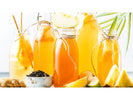
The Healthy Guide To Making Fermented Drinks


Good thing, fermented drinks are not as complicated as they sound. And you can start easy with a recipe that calls for simple ingredients and procedures. For example, water kefir is a good liquid ferment you can start with. The procedure calls for water and sugar mixed with water kefir grains for the first stage. Then, after several days, the grains will be removed and the liquid can be flavored according to your taste.
Quick to follow, right? And since fermented drinks are gaining more popularity nowadays, we thought to share a step-by-step guide on how to ferment drinks. Instead of scouring the internet for instructions, recipes, and whatnot, we have compiled everything you need to know to get started on fermented drinks.
Fermented drinks are made from fruit juices, herbs, soaked grains, and teas that have undergone the process of culturing or fermentation for a certain period.
Fermentation is the chemical breakdown of substances such as bacteria, microorganisms, yeasts, among others. This process is the reason behind the complex infusion of flavors that we come to love in our spirits. We know these beverages like beer and wine. It also includes those with probiotic content such as kombucha, milk kefir, water kefir, tepache, beet kvass, and whey sodas.
Moreover, these drinks are divided into two categories: those that require a SCOBY (Symbiotic Colony of Bacteria and Yeast) and wild ferments (no presence of SCOBY).
Making fermented drinks does not need you to have a background in chemistry. The procedure is easy to follow and will only take a few minutes to complete. However, since these beverages can only acquire their unique taste after a couple of days, it’s the agony of waiting that we have to endure. But good things come to those who wait right?
Here are the most well-known fermented drinks that incorporate bacteria and yeast:
Milk kefir is a fermented milk drink that resembles yogurt and buttermilk. This beverage gives that tangy yet milky taste in every sip. If you are fond of yogurt, then you may also like this one as an alternative.

Water kefir, also known as tibicos, is a traditional fermented drink. This simple drink is only made with water and a symbiotic culture of bacteria. This is consumed as an alternative to milk products or tea-based fermented drinks.

Fill out half of the jar with water. You can use tap, mineralized, or well water.
Jun tea is a naturally fermented drink made with green tea and honey. Just like kombucha and other drinks with SCOBY, jun tea can be fermented twice to make it bubbly. Although compared with kombucha, this beverage has a sweeter and smoother taste.

Here are the most well-known fermented drinks that do not incorporate SCOBY:
If you are in for a sweet, salty, and sour tasting drink, then you may like beet kvass. This bright colored fermented beverage follows the same process of preserving sauerkraut, dill pickles, and kimchi.

A ginger bug is a mixture of ginger, sugar, and water which is allowed to rest for several days until it is properly fermented. This slurry is usually used to ferment root beer, probiotic lemonade, among others.

One of the classifications of fermented drinks is their alcohol content. The amount of alcohol found in these beverages depends on the food source. Certain drinks such as wine and beer are made specifically to contain alcohol. Whereas, wild sodas and kvass are formulated for their probiotic content.
According to a 2019 study, fermented drinks with alcohol are categorized based on the following:
Alcoholic beverages are those that have 0.55%-76% alcohol. These drinks are byproducts of fermentation from grapes, grains, barley, rice, and sugarcane, among others. LAFBs only have an alcohol volume ratio of 1.2% or less. Meanwhile, NAFBs are those with 0.5% or less alcohol content.
Several health benefits are associated with fermented drinks that have minimal alcohol content. The conversion of sugars and starches during the fermentation process enhances the “good” bacteria aka probiotics in our body. Aside from this, the beverages are also loaded with antioxidants and vitamins from various fruits and herbs. Here are the key health benefits of fermented drinks.

The friendly bacteria in our gut are essential for faster metabolism and absorption of nutrients. Probiotics are also known to address digestive problems such as irritable bowel syndrome, diarrhea, and bloating.
Fermented drinks and foods are natural carriers of vitamin C, zinc, and iron which are all key components in maintaining a healthy immune system. It has also been found out that consuming fermented products can boost your body and prevent it from infections such as colds and cough.
The gut and brains are connected through the hypothalamic-pituitary-adrenal (HPA) axis. The former is lined with neurons that can affect our behavior and feelings. An example of this is serotonin, a neurotransmitter found in the intestines. Research suggests that when the gut is happy, the mood will also change accordingly.
Did you enjoy those quick tutorials on how to ferment drinks? We hope that this article made your experience easier, especially if you are just starting out mixing your own fermented drinks. If you'd like to share some tips or recipes for homemade fermented drinks, leave them in the comments section. We would love to hear your thoughts!

